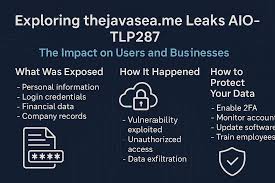What is thejavasea.me and the AIO-TLP287 Leak?
thejavasea.me leaks aio-tlp287 is an online platform often associated with sharing various types of digital content, including software, development resources, and other proprietary information. It has gained notoriety within certain digital communities for its role in disseminating leaked materials. Among the content it has shared, the AIO-TLP287 leak stands out due to its scale and the sensitive information it comprises. This specific leak has raised significant concerns about user privacy and data security, as it exposes internal data that could be utilized maliciously.
The AIO-TLP287 leak contains a trove of information, which may include personal data, usage logs, and possible access credentials associated with several users. The sheer volume of exposed data amplifies the potential risks for individuals whose information has been compromised, as nefarious actors may exploit this data for identity theft and other cybercrimes. Due to the sensitive nature of what has been leaked, there is an urgent need for users to understand the implications and take necessary precautions in response to the data exposure.
The motivations behind such leaks can vary widely, from those seeking financial gain through the sale of stolen data to individuals acting out of malice or for social or political reasons. The relevance of AIO-TLP287 in this broader context cannot be understated, as it reflects increasing vulnerabilities in digital security measures and the persistent threats that individuals and organizations face in the evolving digital landscape. As the exposure of personal and sensitive information becomes more prevalent, understanding the variables behind these leaks, particularly the role of platforms like thejavasea.me, is crucial for enhancing data protection strategies.
Analysis of the Information Exposed in the AIO-TLP287 Leak
The recent leak associated with thejavasea.me leaks aio-tlp287 has raised significant concerns regarding the type and sensitivity of the information exposed. This incident highlights a range of data categories that can be highly detrimental, such as user credentials, financial data, and personal identifiable information (PII). Not only do these leaks pose immediate risks to individual users, but they also reflect systemic vulnerabilities within the platforms affected.
Firstly, user credentials often constitute a significant portion of the leaked data. When such information is compromised, it can lead to unauthorized access to various online accounts, facilitating fraudulent activities and identity theft. The ramifications of these breaches can be far-reaching, potentially affecting users’ financial standing and personal security. Additionally, when financial data is involved, as seen in this leak, the risks amplify considerably. Unauthorized transactions can result in severe financial impacts on individuals, while also damaging the trust relationship between users and platforms.
To illustrate the consequences of similar leaks, one can examine past incidents where exposed data led to drastic outcomes. For instance, the 2017 Equifax data breach, which compromised the personal information of millions, resulted in widespread identity theft and a significant loss of public confidence in data security measures. Experts have noted that such breaches not only affect individual victims but can also weaken overall sector resilience against cyber threats.
The severity of thejavasea.me leaks aio-tlp287 cannot be understated, as these types of data breaches highlight the critical importance of robust data protection strategies. It’s essential for organizations to invest in enhanced security protocols and educate their users about safe online practices to mitigate the effects of such events. The insights gained from expert opinions and historical case studies underscore the need for vigilance in the face of evolving threats in the digital landscape.

Preventative Measures and Best Practices for Users
The recent revelations surrounding thejavasea.me leaks AIO-TLP287 have raised significant concerns regarding personal information security. As users navigate the complexities of digital safety, it is essential to implement robust preventative measures to protect oneself from potential threats stemming from such leaks.
First and foremost, users should adopt the habit of creating strong and unique passwords for each online account. A strong password typically consists of a combination of uppercase and lowercase letters, numbers, and special characters, making it significantly harder for unauthorized entities to compromise accounts. Utilization of a password manager can aid in the generation and storage of these complex passwords, ensuring that they remain secure and easily retrievable.
Additionally, enabling two-factor authentication (2FA) adds an extra layer of protection. This security feature requires users to provide two forms of identification before accessing their accounts. Often, this includes a password plus a code sent to a mobile device or email. By activating 2FA, users can effectively mitigate the risk of unauthorized access even if their passwords are compromised as a result of the leaks related to thejavasea.me.
If individuals suspect that they have been affected by the leaks, taking immediate action is critical. Users should monitor their accounts for suspicious activities and consider changing passwords to those affected accounts promptly. Furthermore, enrolling in credit monitoring services can help identify any misuse of personal information quickly.
Lastly, regularly updating software, applications, and operating systems is vital in maintaining a secure online environment. Updates often include security patches that address vulnerabilities, ensuring devices remain protected against new threats. By implementing these best practices, users can significantly enhance their digital security in light of the challenges posed by thejavasea.me leaks AIO-TLP287.
Future of Data Security in Light of the AIO-TLP287 Leak
The recent incident involving thejavasea.me leaks AIO-TLP287 has underscored the critical importance of data security in an increasingly digital world. As cyber threats evolve, so too must the strategies employed by organizations to protect sensitive information. The evolving tactics of hackers demonstrate a concerning trend towards greater sophistication, enabling cybercriminals to execute targeted attacks that leverage data vulnerabilities. This reality compels companies to reevaluate their cybersecurity frameworks, integrating advanced technologies designed to preemptively address potential breaches.
In response to leaks like AIO-TLP287, firms are increasingly adopting multi-layered security approaches. This includes the implementation of robust encryption methods, which can safeguard data even if unauthorized access occurs. Furthermore, security protocols are becoming more stringent, with an emphasis on regular updates and audits to identify and mitigate vulnerabilities proactively. The incident has propelled companies to invest in artificial intelligence and machine learning systems, which can analyze patterns and detect irregularities in behavior, thus fortifying defenses.
Additionally, regulatory measures are being enhanced to reflect the evolving landscape. As governments across the globe recognize the implications of data breaches, new legislation is emerging to govern data protection. Increased accountability, transparency, and compliance are becoming hallmarks of future data security paradigms. Such regulations are aimed at not only penalizing negligence but also incentivizing best practices in data management.
The future of data security will hinge on collaboration between governments, businesses, and individuals. A unified approach is necessary to create a resilient infrastructure capable of withstanding increasingly sophisticated cyber threats stemming from leaks like those seen in thejavasea.me leaks aio-tlp287 ncident. The ongoing evolution suggests that staying informed and proactive will be essential in navigating the challenges that lie ahead in the domain of cybersecurity.
